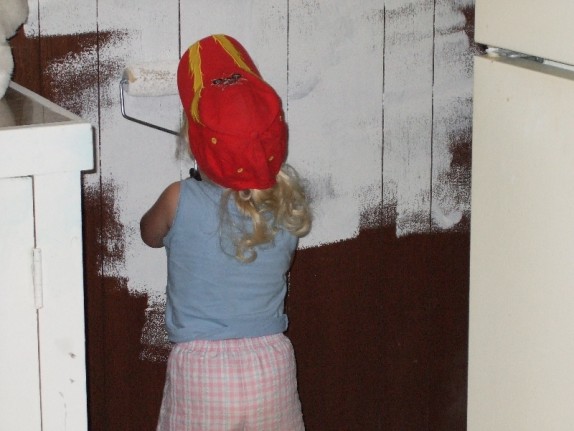Underestimating How Much Paint You Need
Can’t I just pick up a few cans of paint and if I run out go back to the store and buy more?
Buying the Right Amount of Paint at the Beginning Will:
- save you time, you won’t be running back and forth to the store;
- ensures that you have a unified colour, a new batch of paint may not perfectly match the previously bought batch.
Determining How Much Paint You Need:
- add together the length of each wall (ex: 14′ + 20′ + 14′ + 20′ = 68′);
- multiply the sum by the wall height, to find the total wall area (ex: 68′ x 8 ‘= 544sqft);
- divide this figure by the paint coverage, usually one gallon of paint covers 400sqft (ex: 544/400 = 1.36 gallons).
Not Protecting Your Furniture and Your Floor
Why can’t I just move my furniture to the middle of the room and be careful not to drip on the floor?
Covering Your Furniture and Floors Will:
- let’s imagine…you finish your beautiful paint job just to find out that paint has splashed over your favourite sofa or you have ended up with a big blob of paint on your carpet/floor…enough said!
Not Removing the Electrical Covers
Why do I need to remove those electrical covers, can’t I just paint around them?
Removing the Electrical Covers Will:
- take a bit of time but it ensures that you don’t end up with paint all over the electrical covers;
- make a much cleaner and neater room in the end.
Not Preparing Walls Before Painting
Won’t the paint fill in all the nail holes in my walls?
As the Old Saying Goes: Prep Work is 90% of a Good Paint Job:
- paint is not designed to fill holes, it is designed to colour your walls;
- wash down your walls, get the dust, hairs, etc. off the walls, if not they will be a permanent part of your walls once your paint has dried;
- fill all holes, once the plaster has dried, sand down the patches to make a smooth surface.
Not Cutting/Taping
I’ll just put paint on my paintbrush and draw a line along the trim, etc. that should work shouldn’t it?
Why you Should Cut/Tape:
- if you walk into a freshly painted room where someone hasn’t cut/taped, the first thing your eye will be drawn to are the mistakes. The blue paint on the white ceiling or trim…the person dind’t cut/tape;
- use painter’s tape, this is a special tape that comes off easily;
- cutting takes a very steady hand and there is a skill to be learned before you become a good cutter. Educate yourself by watching a few YouTube videos;
- if your ceiling has the “popcorn” effect, taping is impossible; you will have to work on your cutting skills! Make sure to invest in a good brush that is designd for cutting.
Proper Use of a Roller and Paint Brush
Don’t you just pick up the roller and start painting? And why do I need a paintbrush, doesn’t the roller do everything?
Using a Roller Properly:
- is not too difficult if you know what you are doing;
- requires a steady hand and a plan;
- there are a few different approaches to using a roller, it’s about what works for you. Educate yourself by watching a few YouTube videos:
- use an extension pole attached to you hand roller; easier on your body and allows you to paint long, even strokes.
Using a Paint Brush Properly:
- do not skimp when you buy a paintbrush. You need a paintbrush that will hold the paint and will be easy to work with when you want to paint a straight line;
- a paintbrush is needed to cut around the trim and ceiling and paint around outlets and window frames.
Not Using Primer
What is the point of primer, can’t I just paint the walls?
Using Primer on the Surface Will:
- help the paint bond to the wall;
- seal new drywall so not as much paint is needed.
Using Primer on an Already Painted Surface Will:
- block stains;
- help paint bond to the previous paint;
- stop the previous colour from showing through;
- fill tiny irregularities in the wall surface that the paint isn’t designed to fill;
- leave the surface looking smooth and even.
Using Cheap Paint
I want to save money, why can’t I buy the cheapest paint I can find?
Using a Good Quality Paint Will:
- cover the surface much better than a cheap paint. Using cheap paint may require more coats as it is more likely to leave patches and streaks;
- you may find yourself going back to the store for another gallon;
- allow your walls to stand up to washing, cheaper quality paint does not wash as well as quality paint.
Painting Only One Coat of Paint
I want to do this job as fast as I can, why can’t I just paint the surface once?
Minimum Amount of Recommended Coats of Paint is Two;
- first coats of paint are never perfect, with one coat of paint you may not get that deep, solid colour you are looking for;
- walls ar harder to clean if they have been painted with only one coat of paint.
Calling The Professional
Why should I use a professional painter when I can do it myself?
Why You Should Use a Professional Painter;
- a professional painter paints for a living, she/he is experienced at what they do. Professional painters know their business and have the skill and technique to complete a professional job in a timely manner;
- a professional painter has a standard to live up to, this is her/his business. You are the client of the professional painter; she/he has been hired to provide you with top-notch service.
How do I Hire a Professional Painter?
- reputable painting contractors will encourage a written contract/quote. The contract/quote should provide you with detailed information concerning your painting job. The contract/quote should also specify the amount of time the job will take and the payment procedure;
- when you hire a professional painting contractor you have the right to ask for references. Give these references a call and ask questions about the job that this painter performed for them;
- ask the painter if he provides any guarantee or warranty for the work he performs;
- ask the painting contractor if she/he is a member of any trade associations.







